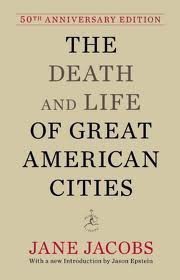LinkFest 2016-01-10
Jerry Pournelle recommended reading Jane Jacobs, so I read The Death and Life of Great American Cities. It was an absolutely fascinating book. In retrospect, I'm not surprised that Jerry recommended it. The Death and Life of Great American Cities is a masterwork from the era of the Kennedy Enlightenment. It represents the best that post-WWII American liberalism had to offer, which was in fact pretty good. However, it also represented a certain amount of hubris, and an over-quantification of things that cannot necessarily be quantified. Jacobs saw something true and good about American cities, and then her disciples tried to enshrine that insight in zoning laws and the results were not uniformly pretty.
The increased risk of death at out of hospital birth isn’t small after all
This was a pretty interesting study in the New England Journal of Medicine. The headline for this study is: out-of-hospital birth more risky than in-hospital. That was intriguing, and after reading the study the best I can say is: maybe. The study used a nice data set from Oregon that allowed the authors to tease out a distinction between births that actually happened out of the hospital, compared with births that were intended to out of the hospital but ended up in the hospital. If you only look at births that happened outside hospitals, the overall risk of perinatal death [stillbirths plus deaths during or shortly after childbirth] is the same as in the hospital. However, if you include women who transfer sometime during labor from outside the hospital to inside, the risk goes up to something like double. This is a tricky study, because the patient populations are way different in these two cases. For one, only something like 4% of all births in Oregon aren't in the hospital, which is among the highest rate in the nation. Also, out-of-hospital births are among women older, whiter, and richer than average. Those things matter. I think the most important sentence in the study is this one from the results section:
In post hoc analyses that assessed the risk of a composite neonatal outcome (fetal death, infant death, a 5-minute Apgar score of less than 4, or neonatal seizures) and the risk of cesarean delivery in subgroups defined according to parity, maternal age, maternal education, and maternal risk profile, we found a significant interaction of maternal age with the planned birth setting for the neonatal composite outcome (P=0.02 for interaction) and of parity and maternal education with planned birth location for the outcome of cesarean section (P<0.001 for interaction for both).
There is a lot to parse here, but when I was trained in statistics, finding an interaction means you don't report on the main effect at all. What do I mean by this? I'll show you a picture from the article to illustrate:

Two of the risk factors really stand out from the rest. Maternal age [meaning 35+] and high-risk [meaning gestational diabetes and/or eclampsia]. Either of those things in isolation increases risk for childbirth. Both together are pretty bad news. I think the real story here is that women over 35 with high-risk pregnancies [diabetes, eclampsia] shouldn't deliver outside of a hospital, but I would have said that without reading this study. To really answer the question, the authors should have compared the risk in the same higher risk population from their in-hospital dataset. Unfortunately, they didn't. I know why the results got spun the way they did. In an era of social media, that is the best way to get attention. I read about this on Twitter [on my phone, no less]. Unfortunately, that carries some risk too.
The New Year's Eve mass sexual assault/riot in Cologne looks really, really bad for Angela Merkel.
Hillary's Emailgate goes Nuclear
John Schindler, current historian, former NSA, wonders about the real source of Sid Blumenthal's email to Hillary Clinton.

The Death and Life of Great American Cities (50th Anniversary Edition) (Modern Library) 50 Anv edition By Jane Jacobs
Comments ()